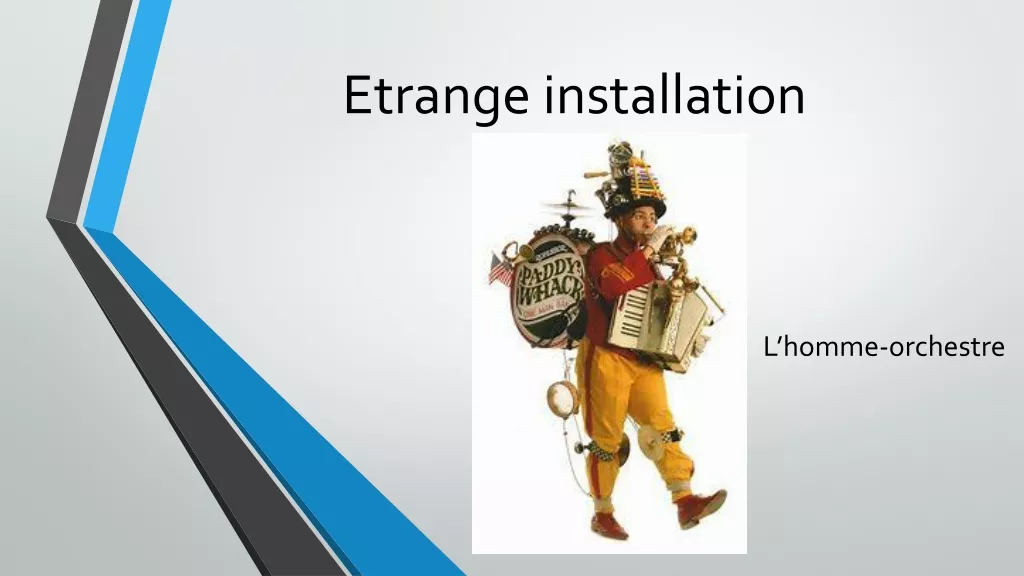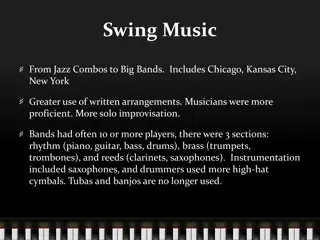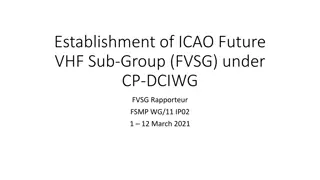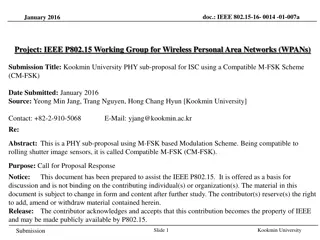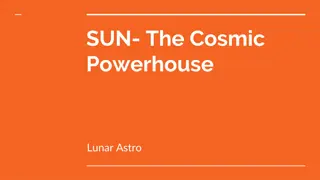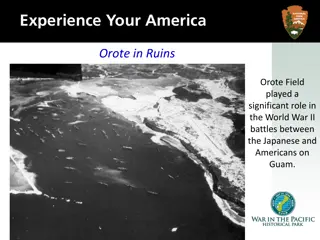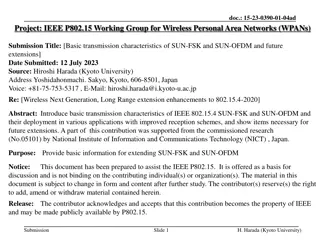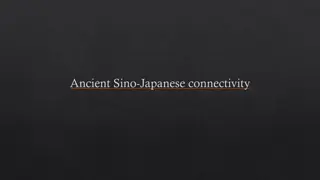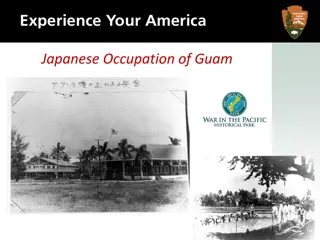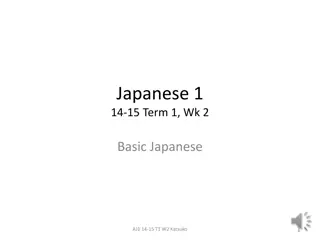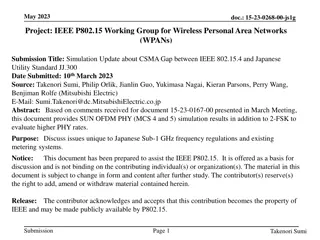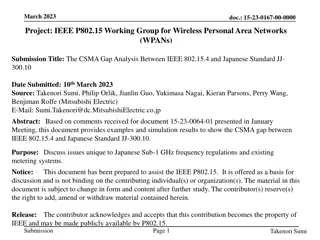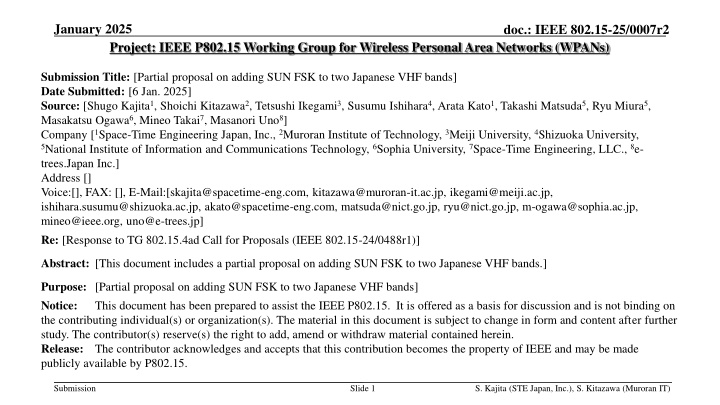
Proposal for Integrating SUN FSK into Japanese VHF Bands
Explore a partial proposal to implement SUN FSK in the Japanese VHF-High Band and UMITS Band for enhanced spectrum utilization in public safety and UAV operations. The document outlines the purpose, scope, and benefits of incorporating SUN FSK modulation to align with upcoming regulatory standards.
Download Presentation

Please find below an Image/Link to download the presentation.
The content on the website is provided AS IS for your information and personal use only. It may not be sold, licensed, or shared on other websites without obtaining consent from the author. If you encounter any issues during the download, it is possible that the publisher has removed the file from their server.
You are allowed to download the files provided on this website for personal or commercial use, subject to the condition that they are used lawfully. All files are the property of their respective owners.
The content on the website is provided AS IS for your information and personal use only. It may not be sold, licensed, or shared on other websites without obtaining consent from the author.
E N D
Presentation Transcript
January 2025 doc.: IEEE 802.15-25/0007r2 Project: IEEE P802.15 Working Group for Wireless Personal Area Networks (WPANs) Submission Title: [Partial proposal on adding SUN FSK to two Japanese VHF bands] Date Submitted: [6 Jan. 2025] Source: [Shugo Kajita1, Shoichi Kitazawa2, Tetsushi Ikegami3, Susumu Ishihara4, Arata Kato1, Takashi Matsuda5, Ryu Miura5, Masakatsu Ogawa6, Mineo Takai7, Masanori Uno8] Company [1Space-Time Engineering Japan, Inc., 2Muroran Institute of Technology, 3Meiji University, 4Shizuoka University, 5National Institute of Information and Communications Technology, 6Sophia University, 7Space-Time Engineering, LLC., 8e- trees.Japan Inc.] Address [] Voice:[], FAX: [], E-Mail:[skajita@spacetime-eng.com, kitazawa@muroran-it.ac.jp, ikegami@meiji.ac.jp, ishihara.susumu@shizuoka.ac.jp, akato@spacetime-eng.com, matsuda@nict.go.jp, ryu@nict.go.jp, m-ogawa@sophia.ac.jp, mineo@ieee.org, uno@e-trees.jp] Re: [Response to TG 802.15.4ad Call for Proposals (IEEE 802.15-24/0488r1)] Abstract: [This document includes a partial proposal on adding SUN FSK to two Japanese VHF bands.] Purpose: [Partial proposal on adding SUN FSK to two Japanese VHF bands] Notice: This document has been prepared to assist the IEEE P802.15. It is offered as a basis for discussion and is not binding on the contributing individual(s) or organization(s). The material in this document is subject to change in form and content after further study. The contributor(s) reserve(s) the right to add, amend or withdraw material contained herein. Release: The contributor acknowledges and accepts that this contribution becomes the property of IEEE and may be made publicly available by P802.15. Submission Slide 1 S. Kajita (STE Japan, Inc.), S. Kitazawa (Muroran IT)
January 2025 doc.: IEEE 802.15-25/0007r2 Background Japanese VHF-High Band The Ministry of Internal Affairs and Communications (MIC) is in the process of initial round of rule- making to introduce Narrowband IoT Communication Systems in the Japanese VHF-High band (170 177.5 and 217.5 222 MHz). One of their primary use cases is public safety applications including disaster response and recovery operations. SUN FSK and SUN OFDM already defined in other frequency bands are being considered as the foundation for the initial rules [3]. However, it is anticipated that standards tailored specifically for the VHF-High Band will be developed before the second round of rule-making begins. Japanese Unmanned Mobile Image Transmission System (UMITS) Band The MIC is also exploring the possibility of implementing narrowband channelization in the UMITS band (169.05 169.3575 MHz and 169.8075 170 MHz) to improve spectrum utilization for command and control (C2) links used in unmanned aerial vehicle (UAV) operations. Currently, no specific channel spacing or channel plan exists for narrowband channels in the rules governing this licensed band. However, a standardized channel plan with defined channel spacing is being considered to facilitate better spectrum management. Submission Slide 2 S. Kajita (STE Japan, Inc.), S. Kitazawa (Muroran IT)
January 2025 doc.: IEEE 802.15-25/0007r2 Purpose and Scope of this proposal This partial proposal aims to add a set of operating modes to the SUN PHY for the Japanese VHF-High Band and UMITS Band, aligning with the rules currently being considered or investigated. This proposal focuses exclusively on SUN FSK for the following reasons: The proposed operating modes should be compatible with off-the-shelf IEEE 802.15.4 radio modules to reduce device manufacturing time and costs. Off-the-shelf IEEE 802.15.4 radio modules designed for Wireless M-Bus (N mode) in the 169 MHz band are available, offering some programmability in operating frequencies, modulation, and channel parameters for the Japanese VHF bands. Adopting a constant envelope modulation scheme like FSK is both energy-efficient and cost-effective for high-power transmission radios, as it significantly reduces the performance requirements for power amplifiers compared to non-constant envelope modulation schemes. This proposal is partial and can be merged with other proposals for the same frequency bands, if applicable. Submission Slide 3 S. Kajita (STE Japan, Inc.), S. Kitazawa (Muroran IT)
January 2025 doc.: IEEE 802.15-25/0007r2 Proposed Changes to the Existing SUN FSK This proposal aims to preserve the existing SUN Narrowband FSK standard with minimal modifications, except for the following aspects: Support for a Wide Range of Data Rates: The symbol period used for MAC and PHY timing parameters is adjusted to 20 s, replacing the symbol period of operating mode #1 currently specified in the standard. Coexistence with a Wide Range of Channel Bandwidths Using Energy Detection (ED): To enable coexistence among operations with different channel bandwidths, narrower channel operations may perform ED over a bandwidth wider than their operational bandwidth. The specific bandwidth for ED, as well as the necessity of performing ED, is determined by the regulatory requirements for the corresponding band. Submission Slide 4 S. Kajita (STE Japan, Inc.), S. Kitazawa (Muroran IT)
January 2025 doc.: IEEE 802.15-25/0007r2 Proposed Changes to the Existing SUN FSK A set of operating modes with varying channel bandwidths is proposed. Modes with narrower bandwidths provide extended communication range at reduced speeds, while those with wider bandwidths enable higher-speed communication over shorter distances. To enable the coordinator to flexibly select the optimal mode based on the range and speed requirements of a given communication environment, multiple operating modes are defined, with data rates doubling incrementally, starting from the base data rate of the narrowest 12.5 kHz bandwidth. The proposed data rates assume Gaussian filtering (BT = 0.5) and aim to maintain a consistent ratio to channel spacing (R) within the given frequency band. This approach seeks to maximize throughput while adhering to the Adjacent Channel Power Ratio (ACPR) requirements currently under consideration or investigation by local regulators. VHF-High Band: R = 0.75 or 0.8 (2-FSK) and 1.0 (4-FSK) Target ACPR requirements: -25 dBc for adjacent channels and -35 dBc for alternate channels UMITS Band: R = 0.4 (2-FSK) and 0.64 (4-FSK) Target ACPR requirement: -45 dBc for adjacent channels across all channel spacings Submission Slide 5 S. Kajita (STE Japan, Inc.), S. Kitazawa (Muroran IT)
January 2025 doc.: IEEE 802.15-25/0007r2 Proposed Modulation and Channel Parameters for the VHF-High Band Two data rates are defined for each channel spacing in the VHF-High Band. Both rates are modulated with 2-FSK for the 12.5 kHz channel spacing, where the lower rate is defined for long-range communications. For all other channel spacings, the lower rate utilizes 2-FSK while the higher rate uses 4-FSK. The 4-FSK modulation requires a higher SNR but delivers a higher data rate within the same bandwidth. Operating mode Frequency band (MHz) Parameter #1 #2 #3 #5 #7 #9 #11 Data rate (kb/s) 5 10 20 40 75 150 300 Modulation 2-FSK 2-FSK 2-FSK 2-FSK 2-FSK 2-FSK 2-FSK Modulation index 0.5 0.5 0.5 0.5 0.5 0.5 0.5 Channel spacing(kHz) 12.5 12.5 25 50 100 200 400 170 177.5 #4 #6 #8 #10 #12 217.5 222 Data rate (kb/s) 25 50 100 200 400 Modulation 4-FSK 4-FSK 4-FSK 4-FSK 4-FSK Modulation index 0.33 0.33 0.33 0.33 0.33 Channel spacing(kHz) 25 50 100 200 400 Submission Slide 6 S. Kajita (STE Japan, Inc.), S. Kitazawa (Muroran IT)
January 2025 doc.: IEEE 802.15-25/0007r2 Proposed Modulation and Channel Parameters for the UMITS Band Similar to the VHF-High Band, two data rates are defined for each channel spacing in this band. However, in this band, the lower rate utilizes 2-FSK, while the higher rate uses 4-FSK for all channel spacings. For the same channel spacing, the data rates in this band are lower than those in the VHF-High Band due to stricter ACPR requirements. Operating mode Frequency band (MHz) Parameter #1 #3 #5 #7 #9 #11 Data rate (kb/s) 5 10 20 40 80 120 Modulation 2-FSK 2-FSK 2-FSK 2-FSK 2-FSK 2-FSK Modulation index 0.5 0.5 0.5 0.5 0.5 0.5 Channel spacing(kHz) 12.5 25 50 100 200 300 169.05 169.3575 #2 #4 #6 #8 #10 #12 169.8075 170 Data rate (kb/s) 8 16 32 64 128 192 Modulation 4-FSK 4-FSK 4-FSK 4-FSK 4-FSK 4-FSK Modulation index 0.33 0.33 0.33 0.33 0.33 0.33 Channel spacing(kHz) 12.5 25 50 100 200 300 Submission Slide 7 S. Kajita (STE Japan, Inc.), S. Kitazawa (Muroran IT)
January 2025 doc.: IEEE 802.15-25/0007r2 ACPR Measurements of Proposed Modulation and Channel Parameters We have been conducting a measurement campaign in urban, suburban, and mountainous areas of Japan using the proposed operating modes #1, #2, #3, #5, #7, #9, and #12 (2-FSK) in the VHF-High Band [1]. For these field measurements, the radio prototype is configured with Gaussian filtering (BT = 0.5), no FEC, and a transmission power of 5 W. The ACPRs of the proposed operating modes for higher/upper adjacent and alternate channels (applicable only to the VHF-High Band) are also measured using the same radio prototype. ACPR Measurement Configuration (Anritsu MS2840A) SPAN 7 BN 100 Hz (SPAN 700 kHz), 10 Hz (SPAN < 700 kHz) RBW VBW Same as RBW Attenuator 0 dB (Internal), 50 dB (External) Detector type RMS Average (over 10 counts) Submission Slide 8 S. Kajita (STE Japan, Inc.), S. Kitazawa (Muroran IT)
January 2025 doc.: IEEE 802.15-25/0007r2 ACPR Measurements of Proposed Modulation and Channel Parameters for the VHF-High Band All the operating modes meet the ACPR criteria for both adjacent and alternate channels, with a margin exceeding 3 dB from the target ACPRs of -25 dBc (adjacent) and -35 dBc (alternate). Power (dBm) ACPR (Adjacent) ACPR (Alternate) Center frequency (MHz) Operating Mode Configured 37 37 37 37 37 37 37 37 37 37 37 37 Measured 36.1 36.3 36.4 36.3 36.2 36.2 36.1 36.1 36.2 36.2 36.2 36.3 Upper -52.7 -29.6 -29.2 -31.6 -28.2 -31.2 -29.5 -29.9 -28.5 -28.8 -28.6 -28.2 Lower -51.5 -28.7 -28.7 -31.2 -28.0 -31.0 -29.4 -29.5 -28.5 -28.7 -28.6 -28.1 Upper -76.0 -68.9 -67.2 -70.2 -65.6 -68.1 -66.4 -68.2 -69.4 -70.1 -71.6 -74.1 Lower -76.3 -68.4 -67.0 -70.1 -65.7 -68.1 -66.4 -68.1 -69.3 -70.1 -71.6 -74.3 #1 #2 #3 #4 #5 #6 #7 #8 #9 #10 #11 #12 220 * Operating Modes with gray background are modulated with 4-FSK. Submission Slide 9 S. Kajita (STE Japan, Inc.), S. Kitazawa (Muroran IT)
January 2025 doc.: IEEE 802.15-25/0007r2 ACPR Measurements of Proposed Modulation and Channel Parameters for the UMITS Band All operating modes in the UMITS Band also meet the ACPR criteria for adjacent channels, with a margin exceeding 3 dB from the target ACPR of -45 dBc for adjacent channels. Power (dBm) ACPR (Adjacent) Center frequency (MHz) Operating Mode Configured Measured Upper Lower #1 30 28.9 -51.8 -50.6 #2 30 28.6 -52.8 -51.7 #3 30 29.3 -51.4 -50.8 #4 30 29.2 -52.5 -51.9 #5 30 29.3 -50.9 -50.6 #6 30 29.2 -52.1 -51.8 169.22 #7 30 28.4 -50.1 -50.0 #8 30 28.4 -51.1 -51.1 #9 30 29.2 -48.9 -48.8 #10 30 29.1 -49.3 -49.3 #11 30 29.2 -48.5 -48.3 #12 30 29.2 -48.2 -48.2 * Operating Modes with gray background are modulated with 4-FSK. Submission Slide 10 S. Kajita (STE Japan, Inc.), S. Kitazawa (Muroran IT)
January 2025 doc.: IEEE 802.15-25/0007r2 Summary Our partial proposal for adding SUN FSK to the two Japanese VHF bands, namely the VHF- High Band and the UMITS Band, has been presented. We will conduct a simulation study using the TG4ad channel model and the interference model, as outlined in the Next Generation SUN PHY Technical Guidance Document (DCN 15-24- 0061-16). Submission Slide 11 S. Kajita (STE Japan, Inc.), S. Kitazawa (Muroran IT)
January 2025 doc.: IEEE 802.15-25/0007r2 References [1] M. Takai, S. Kitazawa, S. Kajita, Diversified Range IoT (DR-IoT) for Disaster Response Applications, DCN: 802.15-24/0507r1. [2] Ministry of Internal Affairs and Communications, FY 2022 Spectrum Reorganization Action Plan, (Abstract, Japanese). [3] Ministry of Internal Affairs and Communications, Consultation on the regulatory rules of the VHF-High Band, (Japanese). [4] Information and Communications Council, Report on the regulatory rules of the 169 MHz band systems, (Japanese). Submission Slide 12 S. Kajita (STE Japan, Inc.), S. Kitazawa (Muroran IT)

